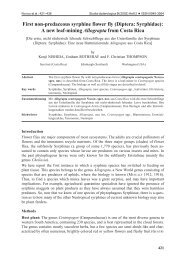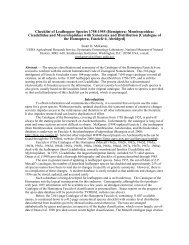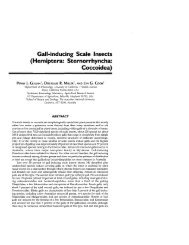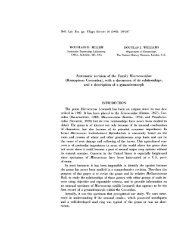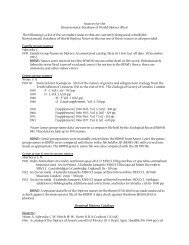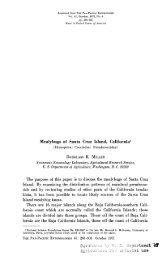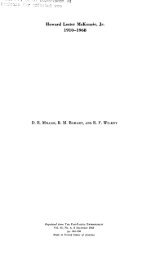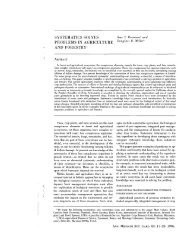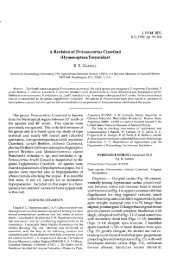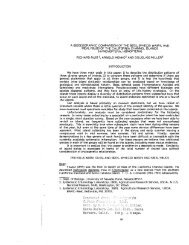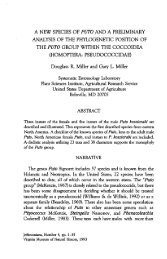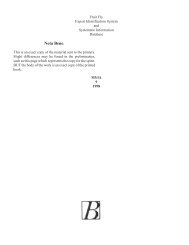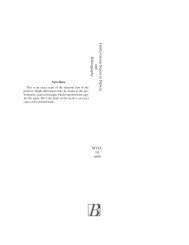Diptera: Anisopodidae - Systematic Entomology Laboratory
Diptera: Anisopodidae - Systematic Entomology Laboratory
Diptera: Anisopodidae - Systematic Entomology Laboratory
- No tags were found...
Create successful ePaper yourself
Turn your PDF publications into a flip-book with our unique Google optimized e-Paper software.
Fiji Arthropods IV. Edited by Neal L. Evenhuis& Daniel J. Bickel. Bishop Museum OccasionalPapers 86: 11–21 (2006).New Mesochria species (<strong>Diptera</strong>: <strong>Anisopodidae</strong>) from Fiji,with notes on the classification of the familyF. CHRISTIAN THOMPSON<strong>Systematic</strong> <strong>Entomology</strong> <strong>Laboratory</strong>, ARS, USDA, c/o Smithsonian Institution, MRC-0169Washington, D. C. 20560 USA; email: cthompso@sel.barc.usda.govAbstract. Two new species of Mesochria from Fiji are described and illustrated: M.schlingeri Thompson, n. sp. and M. vulgaris Thompson, n. sp. A key to genera of <strong>Anisopodidae</strong>and key to the species of Mesochria species are provided, along with notes on theclassification of the family.INTRODUCTIONWood gnats (family <strong>Anisopodidae</strong>) are common flies in forests as their name implies(Sylvicola Harris, the type genus, means “lover of woods” in Latin). They are found on allcontinents except Antarctica and on most major islands (Indonesia, Madagascar, NewZealand, Philippines, West Indies), but are less numerous on smaller, “oceanic” islands,with species only being recorded from the Canaries, Lord Howe, Maderia, New Caledonia,Samoa, Seychelles, and now Fiji. One species has been introduced into the HawaiianIslands (Thompson & Rogers 1992). In the Pacific, only the genera Sylvicola (introducedinto Hawai‘i, otherwise in Australia and New Zealand), Mycetobia Meigen (NewCaledonia) and Mesochria Enderlein (Samoa, Fiji) occur.Only 10 specimens of Mesochria representing 9 species have been reported since thegroup was described about a hundred years ago. In the first years of the current Fiji biologicalsurvey, 73 specimens representing two new species were collected. The differenceis the use of modern collecting techniques like Malaise fly traps along with an organizationalstructure to get the material to specialists for study rather than leaving samples toaccumulate in some museum backlog.Unfortunately, there is little published information on the biology of Mesochria andnot much more on its sister-group, Mycetobia. One species of Mesochria was reared from“a pupa found in rotting banana fibre” in Ghana, western Africa (Keilin & Tate 1940). Thebiology of a number of species of Mycetobia are now known. They are saprophagous andlive in fermenting saps runs or slime fluxes from wounds in trees or in tree holes (Keilin1919, Keilin & Tate 1940, Krivosheina 1997b).MATERIALS AND METHODSMaterial was seen in, borrowed from, or deposited in the following institutions: AmericanMuseum of Natural History, New York (AMNH); the Natural History Museum, London1. Contribution No. 2006-007 to the NSF-Fiji Arthropod Survey.
12BISHOP MUSEUM OCCASIONAL PAPERS: No. 86, 2006(BMNH); Bishop Museum, Honolulu (BPBM); Departamento de Biologia, Universidadede São Paulo, Ribeirão Preto (DBUSP); Fiji National Insect Collection, Suva (FNIC);Institut Recherche Scientifique de Madagascar, Tananarive (IRSM); Musee Royal del’Afrique Centrale, Tervueren (MRAC); Muzeum i Instytut Zoologii, Polska AkademiaNauk, Warsaw (PAN); National Museum of Natural History, Smithsonian Institution,Washington, D.C. (USNM); Zoölogisch Museum, Amsterdam (ZMAN).Morphological terminology and abbreviations follows McAlpine (1981) as modifiedby Thompson (1999). In the material examined section, the use of ellipses (...) followsstandard English practice and merely indicates that the missing information is the same asthat in the preceeding record. For measurements, the number of specimens measured isgiven within parentheses, followed by the range with the average within parentheses; themeasurements are in millimeters.SYSTEMATICSClassification of <strong>Anisopodidae</strong> (sensu lato)The classification used here is conservative and follows from Edwards’ Genera Insectorumtreatment (Edwards 1928b). As is unfortunately typical today, some workers over split thewood gnats into numerous genera, tribes, subfamilies and families. European workers splitthe family into two (<strong>Anisopodidae</strong>, Mycetobiidae) and split Mycetobia into 3 genera(Mycetobia, Trichomycetobia Mamaev, Xeromycetobia Mamaev) (Krivosheina 1997a,b,Mamaev 1987). Amorim & Tozoni (1994) go further and recognize 3 families (Olbiogastridaesplit from <strong>Anisopodidae</strong>) and 11 genera. They overlooked the work of Mamaev, soif one accepts his splitting of the Palaearctic species of Mycetobia into three genera, then thesplit classification would recognize 15 genera distributed among 3 families, 4 named subfamiliesand 4 named tribes, for 155 extant species.Amorim and Tozoni (1994) provided a cladistic analysis, which demonstrated thatthe traditional concepts are monophyletic. The difference between the traditional classificationof Edwards and theirs is merely the splitting of genera, and, hence, elevation of thetraditional generic taxa to higher ranks (Olbiogaster Osten Sacken = OlbiogastridaeHennig, Anisopus = <strong>Anisopodidae</strong>, etc.). This follows from Hennig’s proposal of rankingtaxa based on their age of origin. As there are no accepted scientific methods for rankingtaxa and forming classifications, I justify the use of the broad based traditional arrangementof Edwards on utilitarian grounds. Broader groups are more informative and usefulfor general users. Specialized cladistic information can be encoded with the use of subgeneraand informal groupings, such as series and species groups.There may be more problems with the work of Amorim and Tozoni than those ofranking. A closer look at their treatment of mycetobiine wood gnats reveals a few errors.Their desire to have a classification fit their zoogeographic analysis forced them to combinethe Neotropical and New Caledonia Mycetobia species with the Dominican amberMesochria into a new genus Neomesochria Amorim & Tozoni. Their cladogram listed thefollowing synapomorphies for the mycetobiine genera: Mycetobia, meron “reduced;”Neomesochria, base of M absent or “virtually absent;” Mesochria, eyes “fully holoptic”in both males and females and R 2+3 fused apically with R 1 . Then, in their brief diagnosisof Neomesochria (no description given), they declare that “it is distinct in having the base
Fiji Arthropods–IV: Thompson— Fiji Mesochria (<strong>Anisopodidae</strong>) 13of bM completely absent. It can also be differentiated from Mesochria by the eyes not incontact above the antennae and R 2+3 near but not apically fused to R 1 . Neomesochria, gen.n. differs from Mycetobia in having R2+3 ending at C very near R 1 .” Unfortunately, thesecharacteristics do not agree with reality. All species of Mycetobia and Mesochria also lackvein bM. This is, in fact, the synapomorphy for the subfamily, Mycetobiinae! The terminationof R 2+3 , a) whether in the Costa distant from R 1 (pleisomorphic), b) in the Costa“very near” to R 1 , and c) fused to R 1 (apomorphic) is the character used for the traditionalseparation of Mycetobia (states a, b) and Mesochria (state c). As they correctly noted,this leaves Mycetobia sensu Edwards et alia without a synapomorphy. They noted thatEdwards stated that the Palaearctic species of Mycetobia had the meron “reduced”, andthis condition was “not observed in Neomesochria.” This may be a possible synapomorphyfor Mycetobia, but without an illustration or more precise definition of “reduced”, Icould not evaluate it. What should also be noted is the same problem, lack of a synapomorphy,exists for their new genus, Neomesochria. That is, the intermediate condition ofthe termination of R 2+3 (state b) is not synapomorphy. And they also included in theirNeomesochria, the Dominican amber species (neotropica), which has R 2+3 fused to R 1(state c). The last character provided for their Neomesochria was the condition of the eyes(dichoptic versus holoptic). The nature of the eyes does not correlate with the wing venation.The two species described here clearly have the derived condition for the terminationof R 2+3 , but one is broadly dichoptic and the other is holoptic. So, until a better analysis*is done, I follow the traditional concepts of two sister taxa, Mycetobia and Mesochria,defined by the termination of R 2+3 , which have been considered sister to ValeseguyaColless. The genera here recognized are defined in the key below, which is derived fromEdwards (1928b). Valeseguya and Carreraia Correa were not known to Edwards, so theyhave been added to the key from the literature. Valeseguya, while placed in <strong>Anisopodidae</strong>by its author (Colless 1990), Amorim & Tozoni (1994), and Grimaldi (1991), is apparentlynow considered to represent a distinct family in the Scatopsoidea (Grimaldi & Engel2005: 500–501, attributed to unpublished data of Amorim & Grimaldi).KEY TO THE GENERA OF ANISOPODIDAE, SENSU LATO1. Media three-branched; discal cell (dm) present ..................................................... 4–. Media two-branched; discal cell absent; metatibia with apical comb ................... 22. R 2+3 ending in R 1 [Afrotropical, Oriental, Oceania; fossil in Dominican amber] ............................................................................................. Mesochria Enderlein–. R 2+3 ending in Costa .............................................................................................. 3* For example, pupal characters should be analysed. Keilin and Tate (1940) present data on the pupae ofSylvicola, Mesochria, Mycetobia and Olbiogaster, as well as Trichocera Meigen as an outgroup. From thatdata one might propose the number of stout hooks on the 8th abdominal segment is a morphocline, with 3pairs in Olbiogaster, 5 pairs in Mesochria, 7 pairs in Syvicola and 8 pairs in Mycetobia, and none inTrichocera, then 8 pairs would be a synapomorphy for Mycetobia.The problem of a proper synapomorphy for Mycetobia remains. Hence, the status of the Neotropical andNew Caledonia species of Mycetobia remains to be clarified. But Mesochria neotropica is here reconfirmedas a member of Mesochria, revised status.
Fiji Arthropods–IV: Thompson— Fiji Mesochria (<strong>Anisopodidae</strong>) 156. Costa produced beyond junction with R 4+5 , extending about 1/2 distance to M 1 ; scutumdull, dark brown; 1st palpomere much larger than 2nd and 3rd; halter withdark capitulum ... (Borneo) .............................................. intermedia Edwards–. Costa not produced, ending at junction with R 4+5 ; halter pale .............................. 77. Scutum dull, light ochreous, with dark brown sublateral vitta; 3rd palpomere subequalto 4th ... (Ghana)...................................................... medicorum Edwards— Scutum subshiny, darker, and unmarked; 3rd palpomere about twice as long 4th ...(Seychelles Is) .................................................................... scottiana Enderlein— Scutum yellow, with black medial and sublateral vitta; 3rd palpomere about 1/2 aslong as 4th ... (Zaire) ............................................................... congensis Tollet8. Scutum unicolorous, shiny brown ... (Samoa) ....................... buxtoniana Edwards— Scutum bicolorous, pale with dark markings ........................................................ 89. Scutum yellow with broad sublateral black vitta ... (Fossil, Dominican amber) ................................................................................................ neotropica Grimaldi— Scutum yellow with broad medial and lateral curved vittae ... (Java) ................................................................................................................... cinctipes MeijereMesochria schlingeri Thompson, new species(Figs 2, 3, 5)Diagnosis. This species is readily distinguished from other extant Mesochria species bybeing dichoptic and having two pairs of scutellar bristles. The species is similar to theDominican amber species, neotropica, but is easily distinguished by its leg and scutal coloration.Description. Male. Head. Yellow except black vertex; face shiny, very short yellow pilose; fronssparsely yellow pollinose laterally; eyes (Fig. 1) broadly separated, separated by width of anteriorocellus; vertex black pilose; anterior ocellus about twice as large as lateral ocelli; occiput yellowpilose on ventral 1/2, mainly black pilose dorsally with some yellow pile intermixed anteriorly. Scapeand pedicel orange, black pilose; flagellum black. Palps. 1st palpomere very short, about 1/3 as longas 2nd, equal to 3rd; 2nd palpomere long, about 3 times as long as 1st and 3rd; 3rd short, equal to1st; 4th short, about twice as long as 1st and 3rd, about 2/3 as long as 2nd, blunt apically, withoutapical bristle.Thorax. Yellow except anepisternum and postalar callus brownish orange and with broad sublateralbrown vitta on scutum on medial 1/2, well separated from anterior margin and scutellum, shortblack pilose. Bristles weak, 2 supra-alar, 3 postalar, 2-3 dorsocentrals posteriorly, but two distinctscutellars, one basomedial and other apical. Halter white with capitulum brownish black. Legs. yellow,black pilose except black apical 1/5 on metatibia and black metatarsus except extreme base yellow,with pro- and mesotarsus appearing black apically due to dense black pile; tibial apical spur singleon pro and metatibial, double on mesotibia, but second spur only about 1/3 as large as other. Wing(Fig. 3). Hyaline, microtrichose; subcostal vein bare; Rs setose; M1+2 and both M1 and M2 distinct;CuA distinctly setose, but seta only about 1/2 as long as those on radial veins; A1 distinct.Abdomen. Yellow on basal 4 segments, except indistinct brownish medial macula on 4th segment,black on apical segments, black pilose; male genitalia (Fig. 5) brownish black, cercus orange.Length: Body, not including antenna, 6.0 mm; antenna, 2.0; wing, 5.3 mmType. Holotype (BPBM 16,560), FIJI: Viti Levu: Sigatoka Sand Dunes National Park,malaise trap in costal forest, 177°30'E, 18°10'S, 10 m., 22 Sep– 8 Oct 2002, M.E. Irwin, E.I.Schlinger & M. Tokota’a, (FBA 009142), to be deposited in Fiji National Insect Collection, current-
16BISHOP MUSEUM OCCASIONAL PAPERS: No. 86, 2006Figures 1–2. Heads of male Mesochria. 1. M. vulgaris. 2. M. schlingeri, dorsolateroblique view.Figures 3–4. Wings of Mesochria. 3. M. schlingeri. 4. M. vulgaris.ly held at Bishop Museum, Honolulu. Paratype. FIJI: Viti Levu: 1, K oroyanitu Eco Park, Mt.Evans Range, 0.5 km N of Abaca Village, 177.55°E 17.667°S, 800 m, 26 Nov–3 Dec 2002, Malaisetrap, E. I. Schlinger & M. Tokota’a (FBA 073018) (USNM).Remarks. Mesochria schlingeri is a very distinctive species: Not only do the structuralcharacters separate the species from all others, the coloration is unique and beautiful.The pale yellow abdomen with the apical segments being black, and the pale yellowscutum with dark brown sublateral vittae make an unique color pattern. So among the var-
Fiji Arthropods–IV: Thompson— Fiji Mesochria (<strong>Anisopodidae</strong>) 17Figures 5–10. Male genitalia of Mesochria species. 5, 6, 7. M. schlingeri. 8, 9, 10. M. vulgaris. 5, 8.hypopygium, dorsal view; 6, 9. hypopygium, ventral view. 7, 10. hypopygium, lateral view;ious original descriptions, this species clearly stands out, unlike vulgaris (see below).Etymology. This species is dedicated to Evert I. Schlinger, in recognition of hiseffort to start the Terrestrial Arthropod Survey of Fiji.Mesochria vulgaris Thompson, new species(Figs 1, 4, 6)Diagnosis. This species is most similar to sylvatica, differing from that species as outlinedin the key above.Description. Head. Brownish yellow except brown frons and black vertex; face shiny, very short yellowpilose; eyes (Fig. 2) broadly contiguous for about 1.5 length of vertex; vertex black pilose; ocelliabout equal in size; occiput black pilose. Antenna black except white apical 1/3 of apical flagellomere,black pilose. Palps. 1st and 3rd palpomeres short, about 1/3 as long as 2nd; 2nd palpomerelong, about 3 times as long as 1st and 3rd; 4th short, slightly longer than 1st and 3rd, tapered apically,with stout apical black bristle.Thorax. Brownish except yellow propleuron and more yellowish laterally on scutum, shortblack pilose. Bristles distinct, 2–3 supra-alar, 3 postalar, 6–8 dorsocentrals, 1 apical scutellar. Halterwhite with capitulum pale brownish. Legs. Brownish yellow, black pilose except black apical 1/5 onmetatibia and black metatarsus except extreme base yellow, with pro- and mesotarsus appearingblack apically due to dense black pile; tibial apical spur single on protibia, double on meso- andmetatibia, but second spur only about 1/3 as large as other. Wing (Fig. 4). Hyaline, microtrichose;
18BISHOP MUSEUM OCCASIONAL PAPERS: No. 86, 2006subcostal vein setose on apical 4/5 ventrally; Rs bare; M 1+2 absent, M 2 only distinct on apical 1/3 atwing margin; CuA bare; A 1 only distinctly apically, basal portion absent.Abdomen: terga brownish yellow in males, brown in female, black pilose; sterna yellow, blackpilose; male genitalia brownish (Fig. 6).Length (5). Body, not including antenna, 3.9–5.6 (4.4) mm; antenna, 1.2–1.6 (1.4) mm; wing4.0-5.7 (4.6) mm.Variation. Femora darker in some, metatibia may also be darker basally; abdomen may be palemedially on terga in females.Types. Holotype male (BPBM 16,651), FIJI: Taveuni: Devo Peak Radio Tower, 16°51'S,179°58'E, 1200 m, 10–17 Oct 2002, Malaise trap in rain forest, M.E. Irwin, E.I. Schlinger & M.Tokota’a (FBA 009143), to be deposited in FNIC, currently held at BPBM. Paratypes: FIJI. Taveuni:Devo Peak, 3–16 Jan 2003, Malaise trap, M.E. Irwin, E.I. Schlinger & M. Tokota’a (FBA 038572, 1broken spm); ..., Devo Reserve, 16°50'S 179°58'W, 800 m, 3–10 Jan 2003, Malaise trap in montane wetforest, M.E. Irwin, E.I. Schlinger & M. Tokota’a (FBA041869, 1); ..., Devo Peak Radio Tower,16°51'S, 179°58'E, 1200 m, 31 Oct–21 Nov 2002, Malaise trap in rain forest, M.E. Irwin, E.I. Schlinger& M. Tokota’a (FBA009144, 1); ..., (FBA019743, 1 [in USNM], 019745–019746, 2); Mt Devo,Tavuki village, 16.831°S, 179.98°E, 734 m, 30 Jun–14 Aug 2004, E.I. Schlinger & M. Tokota’a,Malaise trap, (FBA071288, 1 broken spm); ... Devo Peak, 5.6 km SE of Tavuki Village, 16°50'35.7"S,179°57'56.7"E, 1187 m, Malaise trap in cloud forest, M.E. Irwin, E.I. Schlinger & M. Tokota’a(FBA056709-056713, 2, 3); ... (FBA058130–058132, 3 broken spms); ..., 5.3 km SE of TavukiVillage, 16°50'27.4"S 179°58'4.1"W, 1064 m, Malaise trap in montane wet forest, M.E. Irwin, E.I.Schlinger & M. Tokota’a (FBA053432–053436, 3, 1, 1 broken spm); ..., Koronibuabua,16°51'28.3"S, 179°53'37.0"W, 212 m, 4-19 Nov 2003, Malaise trap in lowland rainforest, M.E. Irwin,E.I. Schlinger & M. Tokota’a (FBA046305, 1); ..., Mt Koronibuabua, 3.2 km NW Lavena Village,16.855°S, 179.892°E, 236 m, 4–19 Sep 2003, E.I. Schlinger & M. Tokota’a, Malaise trap, (FBA074337,1). Kadavu: Solodamu, 19°04'S 178°07'E, 128 m, 11 Jun–6 Jul 2003, Malaise trap in costal limestoneforest, M.E. Irwin, E.I. Schlinger & M. Tokota’a (FBA045708, 1). Viti Levu: Nakobolevu, loggingroad behind Suva, 18°03'S, 178°25'E, 340 m, 22 Sep–9 Oct 2002, Malaise trap in rain forest, M.E.Irwin, E.I. Schlinger & M. Tokota’a (FBA009145–0091457, 3); ..., Nakobolevu, 18°03'S, 178°25'E,340 m, 24–29 Oct 2003, Malaise trap in rain forest, M.E. Irwin, E.I. Schlinger & M. Tokota’a(FBA026027–026028, 2); ..., Nakobolevu, 4 km WSW Colo-i-Suva Village, 18.055°S, 178.424°E,372 m, Malaise Trap, E.I. Schlinger & M. Tokota’a (FBA065233, 1); ..., Nakobolevu Peak, RadioTowers behind Suva, 18°03'S, 178°25'E, 460 m, 22 Sep–9 Oct 2002, Malaise trap in rain forest, M.E.Irwin, E.I. Schlinger & M. Tokota’a (FBA009148, 1); ..., Navai, 17°37'S, 177°59'E, 700 m, 15 May–2Jun 2003, Malaise trap in gymnosperm dominated rainforest, M.E. Irwin, E.I. Schlinger & M. Tokota’a(FBA041574, 1); ..., 24 Oct–8 Nov 2003, ... (FBA031660, 1); ..., 6 Jun–15 Jul 2003, ...(FBA029510–029511, 2); ..., 13–18 Feb 2003 (FBA039756–039757 2); ..., PABITRA wabu baselinesurvey, Delena Veikori, 17°35'S, 178°05'E, 1034 m, Malaise trap (FBA053145, 1 broken spm).Vanua Levu: Kilaka, 16°48'29.7"S, 178°59'’11.0"E, 146 m, 3–10 Jun 2004, Malaise trap in lowlandwet forest, M.E. Irwin, E.I. Schlinger & M. Tokota’a (FBA040284–040286, 1, 2); ..., 24 Jun–21 Jul2004,... (FBA028298–028299, 2); ..., 16°48'41.2 "S, 178°59'01.7"E, 154 m, 28 Jun–2 Jul 2004 ...(FBA048289–048295, 2, 5); ..., 16°48'41.2"S 178°59'29.0"E, 98 m; ..., 3–10 Jul 2004, ...(FBA034818–034822, 2, 3); ..., Batigere Range, 6 km NW Kilaka, 16.7317°S, 178.9997°E, 113 m,3–15 Jun 2004, Malaise trap, E.I. Schlinger & M. Tokota’a (FBA069147–069151, 5); ... 16.8057°S,178.9914°E, 98 m, 15–24 Jun 2004, E.I. Schlinger & M. Tokota’a (FBA074678–074677,074580–074581, 3, 1); ..., 16.1653°S, 178.9564°E, 140 m, 15–28 Jun 2004, E. I. Schlinger & M.Tokota’a (FBA072410–072411, 1, 1); ..., 16°31'89.1"S, 179°01'14.7"E, 105 m, Malaise trap in transitionseasonal forest , M.E. Irwin, E.I. Schlinger & M. Tokota’a (FBA046796, 1); ..., 0.4 km SRokosalase, 16.532°S, 179.019°E, 118 m, 23 Apr–8 May 2004, Malaise trap, E.I. Schlinger & M.Tokota’a (FBA066616, 1). Paratypes will be distributed to BMNH, BPBM, DBUSP, FNIC, andUSNM.Remarks. This is the most common Mesochria. Previously the most specimens collectedof any Mesochria species was two. The species is very similar to scottiana and
Fiji Arthropods–IV: Thompson— Fiji Mesochria (<strong>Anisopodidae</strong>) 19medicorum and given that medicorum was bred from rotten banana fibre, these names allmay apply to one common widespread variable species associated with banana.Mesochria vulgaris with scottiana, medicorum, and sylvatica, forms a species group,as all are more or less uniformly brownish to yellowish, with unicolorous legs, and identicalwing venation. Mesochria sylvatica and vulgaris differs from the other two by havingthe apical flagellomere white. Enderlein clearly described the antenna of scottiana,specifically mentioning the apical flagellomere, so one must assume it was dark asdescribed. Edwards in his brief diagnosis of medicorum did not mention the antenna, butas he wrote “otherwise as in scottiana” and had access to a syntype of scottiana, again onemust assume the antennae are entirely black. Stuckenberg does not describe the structureof the palps, merely the relative length of the last and penultimate palpomeres. Somespecies of Mesochria have the last segment tapering apically and with an apical bristle(Fig. 4). From Enderlein’s description, this is the condition in scottiana, and, hence, oneassumes also medicorum. The question is the condition in sylvatica. In summary, as onereads the original descriptions while examining specimens of vulgaris, one realizes allthese species are very similar and what differences that can be found between the variousdescription may be due to error or variation. So, the association with an agricultural plant,banana, which has been widely disseminated throughout the tropical areas where thesespecies occur does suggest alternative hypothesis, one species, not a group of them.Etymology. The epithet, vulgaris, an adjective, is used for this species due to itsabundance.CHECKLIST OF THE SPECIES OF MESOCHRIA ENDERLEIN1. Mesochria buxtoniana Edwards, 1928a: 40. Type-locality: Samoa, Upolu, Malololelei.Holotype in BMNH, London.Distribution: Samoa.2. Mesochria cinctipes de Meijere, 1913: 322. Type-locality: Indonesia, Java, Djakarta.Holotype in ZMAN, Amsterdam.Distribution: Java.3. Mesochria congoensis Tollet, 1956: 29, fig. 11 (male genitalia, ventral view). Typelocality:Zaire, Kishangane [as “Stanleyville”]. Holotype MRAC, Tervueren.Distribution: Zaire.4. Mesochria griveaudi Stuckenberg, 1961: 128. Type-locality: Madagascar, Pèrinet(east-central montane forest zone). Holotype IRSM, Tananarive.Distribution: Madagascar.5. Mesochria intermedia Edwards, 1931: 491. Type-locality: Indonesia, Sabah [as “NorthBorneo”], Bettotan. Holotype BMNH, London.Distribution: Borneo.6. Mesochria medicorum Edwards, 1928b: 26, fig. 6 (habitus). Type-locality: Ghana [as“Gold Coast”], Aburi. Holotype BMNH, London.Distribution: Ghana.7. Mesochria neotropica Grimaldi, 1991: 21, fig. 47 (habitus). Type-locality: DominicanRepublic [amber, Oligocene / Miocene]. Holotype AMNH, New York.Distribution: Oligocene / Miocene. Dominican Republic [amber]8. Mesochria scottiana Enderlein, 1910: 65, fig. 4 (wing). Type-locality: Seychelles Is.,
20BISHOP MUSEUM OCCASIONAL PAPERS: No. 86, 2006Mahé, Cascade Estate, 800–1500 ft. Syntypes 2 BMNH, London & PAN, Warsaw.Distribution: Seychelles Is.9. Mesochria schlingeri Thompson, n. sp. Type-locality: Fiji, Viti Levu, Sigatoka Prov.,Sigatoka Sand Dunes National Park. Holotype FNIC, Suva.Distribution: Fiji.10. Mesochria sylvatica Stuckenberg, 1991: 126. Type-locality: Madagascar,Ambatolampy District, Ankaratra Massif, Vieille Forest, Manjakatompo Forest Station.Holotype IRSM, Tananarive.Distribution: Madagascar.11. Mesochria vulgaris Thompson, n. sp. Type-locality: Fiji, Taveuni, Devo Peak RadioTower. Holotype FNIC, Suva.Distribution: Fiji.ACKNOWLEDGMENTSThe figures were prepared by Lucrecia H. Rodriquez (Figs. 1–4) and Taina Litwak (Figs.5–6). I also thank Drs. Dalton de Souza Amorim, Departamento de Biologia, Universidadede São Paulo; Neal Evenhuis, Bishop Museum, Honolulu; Alma Solis, Alan Norrbom,David Nickle, <strong>Systematic</strong> <strong>Entomology</strong> <strong>Laboratory</strong>, USDA, Washington, D.C.; fortheir critical reviews of the manuscript. Material collected in Fiji was partially supportedby the National Science Foundation project “Terretrial Arthropod Survey of Fiji” (DEB-0425790) and the Schlinger Foundation. The Government of Fiji (Ministries of Environmentand Forestry) are thanked for their continued support of this project.LITERATURE CITEDAmorim, D. de S. & Tozoni, S.H.S. 1994. Phylogenetic and biogeographic analysis of theAnisopodoidea (<strong>Diptera</strong>, Bibionomorpha), with an area cladogram from intercontinentalrelationships. Revista Brasileira de Entomologia 38: 517–543. [1994.12.30]Baylac, M. & Matile, L. 1988. Diptères Anisopodoidea Mycetobiidae de Nouvelle-Calédonie.Mèmoires du Muséum National d’Histoire Naturelle (A) 142: 83–87. [1988.12.23]———. & Matile, L. 1990. Un nouveau Mycetobia de Nouvelle-Calédonie (<strong>Diptera</strong>: Anisopodoidea:Mycetobiidae). Annales de la Société Entomologique de France (N. S.) 26:355–357. [1990.09.28]Colless, D.H. 1990. Valeseguya rieki, a new genus and species of dipteran from Australia(Nematocera: <strong>Anisopodidae</strong>). Annales de la Société Entomologique de France (N.S.)26: 351–353. [1990.09.28]Edwards, F.W. 1916. On the systematic position of the genus Mycetobia, Mg. (<strong>Diptera</strong>,Nematocera). Annals and Magazine of Natural History (8) 17: 108–116. [1916.01.01]———. 1928a. Nematocera. Pp. 23–102 (= fasc. 2, part). In British Museum (NaturalHistory), Insects of Samoa, vol. 4: Pt 6 (<strong>Diptera</strong>), 366 pp. London [1928.06.23]———. 1928b. <strong>Diptera</strong>. Fam. Protorhyphidae, <strong>Anisopodidae</strong>, Pachyneuridae, Trichoceridae.Genera Insectorum 190, 41 pp. [1928.08.??]———. 1931. <strong>Diptera</strong> Nematocera from the lowlands of North Borneo. Journal of theFederated Malay States Museums 16: 486–504. [1931.07.??]
Fiji Arthropods–IV: Thompson— Fiji Mesochria (<strong>Anisopodidae</strong>) 21Enderlein, G. 1910. The Percy Sladen Trust Expedition to the Indian Ocean in 1905under the leadership of Mr J. Stanley Gardiner, M. A. Volume III, No. V - <strong>Diptera</strong>,Mycetophilidae. Transactions of the Linnaean Society, London 14: 59–81.[1910.11.??]Grimaldi, D.A. 1991. Mycetobiine woodgnats (<strong>Diptera</strong>: <strong>Anisopodidae</strong>) from the Oligo-Miocene amber of the the Dominican Republic, and Old World affinities. AmericanMuseum Novitates 3014, 24 pp. [1991.06.27]———. & Engel, M.S. 2005. Evolution of the insects. Cambridge University Press,Cambridge. xv + 755 pp. [before 2005.05.12]Keilin, D. 1919. On the structure of the larvae and the systematic position of the generaMycetobia Meigen, Ditomyia Winnertz and Symmerus Walker (<strong>Diptera</strong>, Nematocera).Annals and Magazine of Natural History (9) 3: 33–42, pls. 2-5. [1919.01.??]———., & Tate, P. 1940. The early stages of the families Trichoceridae and <strong>Anisopodidae</strong>(= Rhyphidae) (<strong>Diptera</strong>: Nematocera). Transactions of Royal EntomologicalSociety, London 90: 39–62. [1940.06.15]Krivosheina, N.P. 1997a. Family <strong>Anisopodidae</strong>. Pp. 239–248. In: Papp, L. & Darvas, B.(eds.), Contributions to a Manual of Palaearctic <strong>Diptera</strong> (with special reference toflies of economic importance). Vol. 2, Nematocera and Lower Brachycera. ScienceHerald, Budapest. 592 pp. [1997.11.30]———. 1997b. Family Mycetobiidae. Pp. 249–254. In: Papp, L. & Darvas, B. (eds.),Contributions to a Manual of Palaearctic <strong>Diptera</strong> (with special reference to flies ofeconomic importance). Vol. 2, Nematocera and Lower Brachycera. Science Herald,Budapest. 592 pp. [1997.11.30]Mamaev, B.M. 1987. Dipterous insects of the family Mycetobiidae of the USSR fauna.Vestnik Zoologii 2: 20–27. [In Russian, with English abstract]. [1987.01.26]McAlpine, J.F. 1981. Morphology and terminology—adults. Pp. 9–63. In: McAlpine, J.F., et alia (coords.), Manual of Nearctic <strong>Diptera</strong>. Vol. 1. Research Branch, AgricultureCanada, Monograph 27. vi + pp. 1–674. [1981.03.31]Meijere, J.C.H. de 1913. Studien über sutostasiatiche Dipteren. VII. Tijdschrift voorEntomologie 56: 317–354, pls 15–17. [1913.12.20]Stuckenberg, B.R. 1961. Records and descriptions of <strong>Diptera</strong> from Madagascar. Part I.<strong>Anisopodidae</strong>, and Mycetophilidae genus Allactoneura de Meijere. Naturaliste malgache12[1960]: 123–132. [1961.05.??]Thompson, F.C. & Rogers, T. 1992. Sylvicola cinctus (Fabricius), the Hawaiian WoodGnat, with notes on the family (<strong>Diptera</strong>: <strong>Anisopodidae</strong>). Proceedings of theHawaiian Entomological Society 31: 47–57. [1992.12.31]———. 1999. A key to the genera of the flower flies of the Neotropical Region includingthe description of genera and species and a glossary of taxonomic terms. Contributionson <strong>Entomology</strong>, International 3: 319–378. [1999.08.23]Tollet, R. 1956. <strong>Anisopodidae</strong> (<strong>Diptera</strong> Nematocera). Exploration du Parc NationalAlbert. Mission G. F. de Witte 86: 15–34. [1956.10.30]
22BISHOP MUSEUM OCCASIONAL PAPERS: No. 86, 2006



